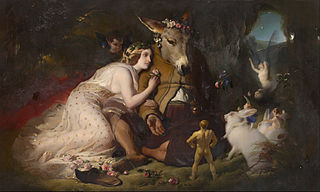See also
| This disambiguation page lists articles associated with the title Fairy Queen. If an internal link led you here, you may wish to change the link to point directly to the intended article. |
The Fairy Queen , in English folklore, traditionally ruled the fairies.
Fairy Queen may also refer to:
| This disambiguation page lists articles associated with the title Fairy Queen. If an internal link led you here, you may wish to change the link to point directly to the intended article. |

Henry Purcell was an English composer. Although he incorporated Italian and French stylistic elements, Purcell's was a uniquely English form of Baroque music. He is generally considered to be one of the greatest English composers; no later native-born English composer approached his fame until Edward Elgar, Ralph Vaughan Williams, William Walton and Benjamin Britten in the 20th century.
TamLin is a character in a legendary ballad originating from the Scottish Borders. It is also associated with a reel of the same name, also known as the Glasgow Reel. The story revolves around the rescue of Tam Lin by his true love from the Queen of the Fairies. The motif of capturing a person by holding him through all forms of transformation is found throughout Europe in folktales.

Oberon is a king of the fairies in medieval and Renaissance literature. He is best known as a character in William Shakespeare's play A Midsummer Night's Dream, in which he is King of the Fairies and spouse of Titania, Queen of the Fairies.
Queen Mab is a fairy referred to in William Shakespeare's play Romeo and Juliet, where "she is the fairies' midwife." Later, she appears in other poetry and literature, and in various guises in drama and cinema. In the play, her activity is described in a famous speech by Mercutio written originally in prose and often adapted into iambic pentameter, in which she is described as a miniature creature who performs midnight pranks upon sleepers. Being driven by a team of atomies, she rides her chariot over their noses and "delivers the fancies of sleeping men." She is also described as a midwife to help sleepers "give birth" to their dreams. She may be a figure borrowed from folklore, and though she is often associated with the Irish Medb in popular culture, and has been suggested by historian Thomas Keightley to be from Habundia, a more likely origin for her name would be from Mabel and the Middle English derivative "Mabily" all from the Latin amabilis ("lovable").
A fairy is a type of mythical being or legendary creature in European folklore.
Beauty and the Beast is a traditional fairy tale.

Titania is a character in William Shakespeare's 1595–1596 play A Midsummer Night's Dream. In the play, she is the queen of the fairies. Due to Shakespeare's influence, later fiction has often used the name "Titania" for fairy queen characters.
Snow White is a popular fairy tale.
Snow Queen may refer to:

The Fairy-Queen is a semi-opera by Henry Purcell; a "Restoration spectacular". The libretto is an anonymous adaptation of William Shakespeare's comedy A Midsummer Night's Dream. First performed in 1692, The Fairy-Queen was composed three years before Purcell's death at the age of 35. Following his death, the score was lost and only rediscovered early in the twentieth century.
The Faery Queen may be:
The terms "semi-opera", "dramatic[k] opera" and "English opera" were all applied to Restoration entertainments that combined spoken plays with masque-like episodes employing singing and dancing characters. They usually included machines in the manner of the restoration spectacular. The first examples were the Shakespeare adaptations produced by Thomas Betterton with music by Matthew Locke. After Locke's death, a second flowering produced the semi-operas of Henry Purcell, notably King Arthur and The Fairy-Queen. Semi-opera received a deathblow when the Lord Chamberlain separately licensed plays without music and the new Italian opera.
King Arthur is a legendary king of the Britons.
Gary Stadler is an American new-age pianist, composer, songwriter and producer, specializing in contemporary Celtic-influenced themes and atmospheres. Stadler's six albums generally focus on imaginative concepts loosely based in Celtic mythology, especially stories of the realm of Faerie. His music combines melodic elements of rare world instruments, mastery of synthesizer orchestrations and studio techniques. Three of his albums feature collaborations with vocalists Singh Kaur, Stephannie and Wendy Rule.
A fairy tale is a story featuring folkloric characters.
The Lady of the Lake is the name of several related characters in the Arthurian legend.

Fablehaven is a 2006 fantasy novel written by Brandon Mull about two siblings whose grandparents, unbeknownst to their family, are the owners of a nature preserve for magical creatures. Mull's first published book, it received largely positive reviews, with ratings of 4.7 and 4.08 on Amazon and GoodReads, as well as a number of commendations from other authors and critics.
Miriam Allan is an Australian Soprano.
The Fairy Queen is a character in Brandon Mull's 2000s children's fantasy series Fablehaven.

The Fairy Queen or Queen of the Fairies is a figure from Irish and British folklore, believed to rule the fairies. Based on Shakespeare's influence, in English-speaking cultures she is often named Titania or Mab.